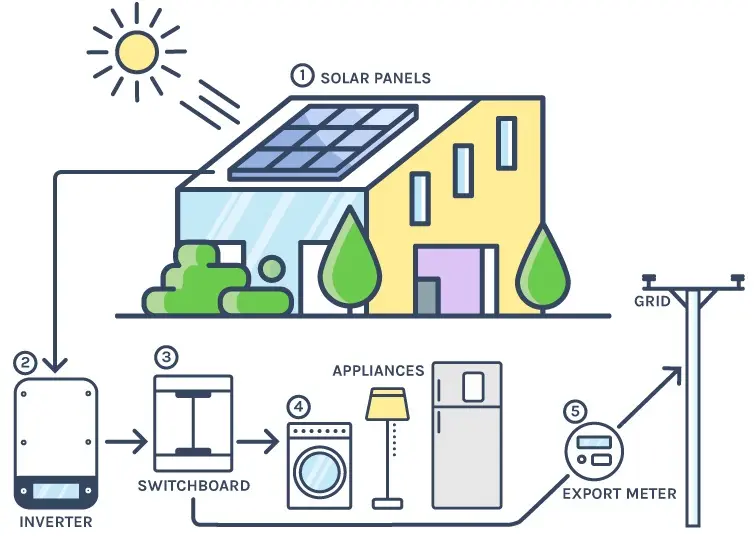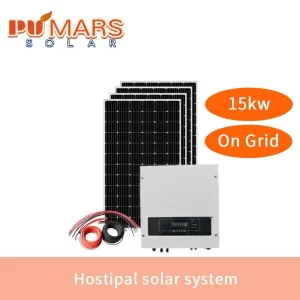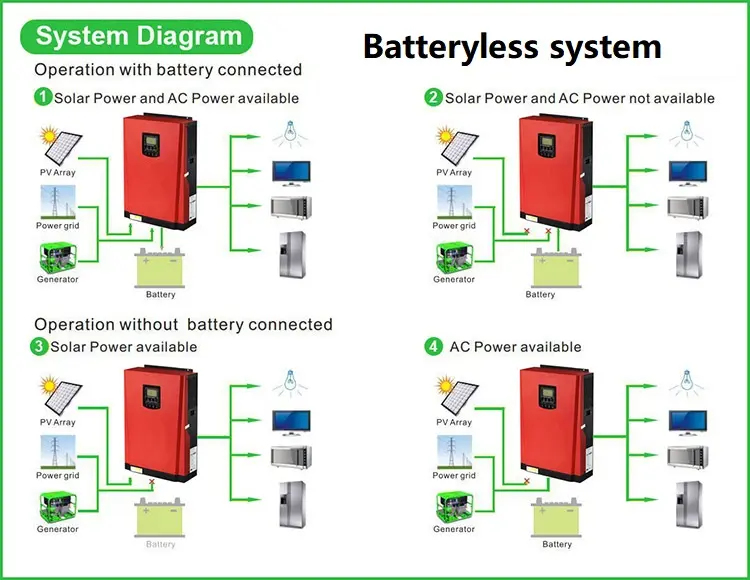Consumers care about environmental protection and greenness, but they are more concerned about greenness in their wallets.
On-grid solar systems save utility bills, provide quick ROI (return on investment), positive ROI, and increase property value.
And, for business owners, reduced costs and increased benefits. There are also significant intangible benefits such as energy independence and a cleaner, healthier lifestyle.
As well as solar power generation, the grid-connected system can also generate power from wind turbines or both.
PVMARS provides various renewable energy solutions and also provides cost-effective and high-quality products.
You can quickly get the information you need through key content.
However, there are many brands of on-grid solar systems on the market. How do we compare and choose?
Grid-tied solar systems can broadly be divided into solar panel and on-grid inverter brands. PVMARS cooperates with many solar panel brands and purchases solar cell crystalline silicon wafers in large quantities for production.
The following video is about our factory and how we produce solar panels.
Therefore PVMARS can provide very low solar panel prices. Solar panels cost 0.15usd/watt – 0.24usd/watt.
For on-grid solar systems, solar panels cost slightly more than off-grid PV panels. This is because grid-tied systems have no batteries to store and therefore require higher-quality solar panels to generate electricity and transmit it to the utility grid.
If you use a on-grid solar system, you must understand its working mode.

On-grid solar systems lack batteries. It is because it is connected to a larger battery than the physical battery – the utility grid. The utility grid is like a virtual battery. During the day, power from the solar panels is transferred through a grid-tied inverter to your equipment and the utility grid.
Then at night, you can tap into all the energy solar panels produce during the day which is stored on the utility grid.
While reducing electricity bills, according to your local power grid policy and with the grid connection license provided by PVMARS, you can sell excess electricity and make profits.
By adding a CT meter to the AC output of the grid-connected inverter, you can prevent backflow which is solar current from flowing into the utility grid.

There are also battery-less systems (that is, no electricity is sold). The special feature of this type of system is the inverter.
Traditional grid-connected systems can sell electricity, but in the event of a grid failure, the entire solar system will stop supplying power – the main reason is to protect the personal safety of local workers repairing the grid.
If you don’t want to be unable to use solar energy during a power outage, you can choose a battery-free solar system.
It can supply you with solar power without a grid and battery backup (provided there is sunlight and the solar panels can generate electricity).

If your city grid has no power supply for 5-8 hours a day, you can consider a solar energy storage system or a wind-solar hybrid energy storage system.
We can see the importance of on-grid inverters in grid-connected solar systems. PVMARS lists 5 different inverter brands here with their prices.
You can compare, choose a suitable grid-tied inverter, and DIY your on-grid solar system.
Grid-tied inverters are string inverters. For example, 100kw power can be generated by using 10 x 10kw on-grid inverters combined in series to output.
Or 2 x 50kw on-grid inverters can be connected in series to output 100kw power. Due to their high operability and flexibility, they are suitable for DIY on-grid solar system design.
3KW string on-grid inverter comparison:
| Brand | EXW Price |
| Growatt | US$ 388 |
| Deye | US$ 381 |
| Invt | US$ 389 |
| GoodWe | US$ 355 |
| Sofar | US$ 347 |
What is the EXW price? Please click on the orange text to jump to the relevant page to learn more.
5KW string grid-tied inverter comparison:
| Brand | EXW Price |
| Growatt | US$ 541 |
| Deye | US$ 523 |
| Invt | US$ 419 |
| GoodWe | US$ 440 |
| Sofar | US$ 423 |
6KW string grid-tied inverter comparison:
| Brand | EXW Price |
| Growatt | US$ 541 |
| Deye | US$ 550 |
| Invt | US$ 430 |
| GoodWe | US$ 436 |
| Sofar | US$ 431 |
10KW string on-grid inverter comparison:
| Brand | EXW Price |
| Growatt | US$ 846 |
| Deye | US$ 837 |
| Invt | US$ 584 |
| GoodWe | US$ 575 |
| Sofar | US$ 541 |
15KW 3-phase on-grid inverter comparison:
| Brand | EXW Price |
| Growatt | US$ 947 |
| Deye | US$ 776 |
| Invt | US$ 724 |
| GoodWe | US$ 592 |
| Sofar | US$ 575 |
20KW 3-phase on-grid inverter comparison:
| Brand | EXW Price |
| Growatt | US$ 1319 |
| Deye | US$ 849 |
| Invt | US$ 970 |
| GoodWe | US$ 634 |
| Sofar | US$ 634 |
30KW 3-phase on-grid inverter comparison:
| Brand | EXW Price |
| Growatt | US$ 1505 |
| Deye | US$ 1190 |
| Invt | US$ 1136 |
| GoodWe | US$ 956 |
| Sofar | US$ 964 |
50KW 3-phase on-grid inverter comparison:
| Brand | EXW Price |
| Growatt | US$ 1826 |
| Deye | US$ 1760 |
| Invt | US$ 1895 |
| GoodWe | US$ 1519 |
| Sofar | US$ 1200 |
100KW 3-phase on-grid inverter comparison:
| Brand | EXW Price |
| Growatt | US$ 3974 |
| Deye | US$ 3023 |
| Invt | US$ 3568 |
| GoodWe | US$ 2824 |
| Sofar | US$ 2706 |
Grid-connected inverters need relevant certificates to enter your country and sell electricity on the grid. Therefore, some grid-connected inverter brands are relatively high because they have complete certificates and apply to any country and region.
Please contact PVMARS to find out which inverter brands have grid connection certificates for your region.
If you want to accurately control the amount of electricity produced by each solar panel, you may consider using the following brands:
| Deye Brand | EXW Price |
| SUN300G3-EU-230 | US$ 181 |
| SUN500G3-EU-230 | US$ 218 |
| SUN600G3-EU-230 | US$ 149 |
| SUN800G3-EU-230 | US$ 165 |
| SUN1000G3-EU-230 | US$ 178 |
| SUN1300G3-EU-230 | US$ 282 |
| SUN1600G3-EU-230 | US$ 299 |
| SUN2000G3-EU-230 | US$ 316 |
| SUN-M60G4-EU-Q0 | US$ 184 |
| SUN-M80G4-EU-Q0 | US$ 191 |
| SUN-M100G4-EU-Q0 | US$ 198 |
On-grid solar is primarily determined by your electricity usage. You can subject to own electricity bill, or download and fill out the load sheet to contact us. We will customize a grid connection kit based on your situation.
Likewise, you can refer to PVMARS’ existing on-grid solar system kits for matching:
If the average monthly electricity consumption is 120kwh – 600kwh, we recommend 1kw-5kw:
The average monthly electricity consumption is 1200kW – 3600kwh. PVMARS recommends 10kw-30kw:





Business owners consume electricity for two-thirds or more of their operating costs. For example, for our customers in Panama, their local electricity bill is very expensive.
If they do not use solar energy, their annual electricity bill will be 90,000 PAB.
Now they have used 3 x 10kw on-grid solar systems from PVMARS and realized profits in the fifth month. For more details, click on the article below to read.
For monthly electricity consumption higher than 3600kwh, we recommend choosing: 50kw-300kw, and above.





DIYing your on-grid solar system requires final installation. Download our easy-to-follow installation instructions for on-grid solar systems.
PVMARS provides installation services if required. For example, our installation team arrived in Malaysia and completed the installation of a 1MW grid-connected solar system.
The grid-connected solar system now powers their hospital and generates profits.
If the local sunshine is insufficient, you can consider a grid-connected wind turbine system and a on-grid wind and solar hybrid system:

The above on-grid solar systems all sell electricity. If you don’t want to sell electricity, or there is no such policy locally, consider battery-less solar systems: PVMARS offers 3kw-10kw. It can be connected in series to increase capacity.

Contact us to maximize your benefits and choose what’s right for you, not the cheapest or most expensive.
PVMARS | Foshan PVMars Solar Technology Co.,Ltd. © 2007-2024 All Rights Reserved.